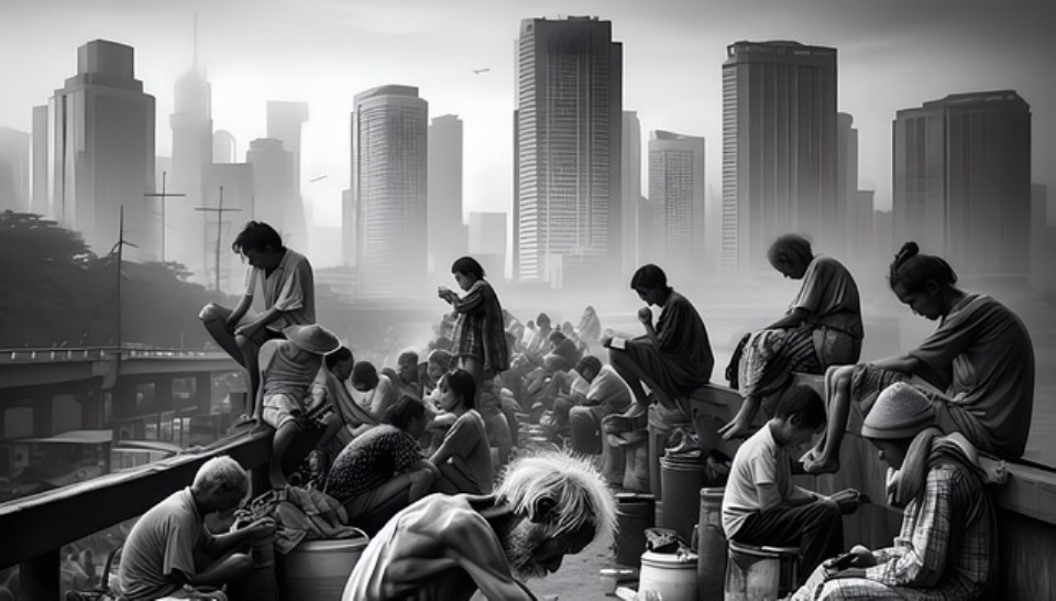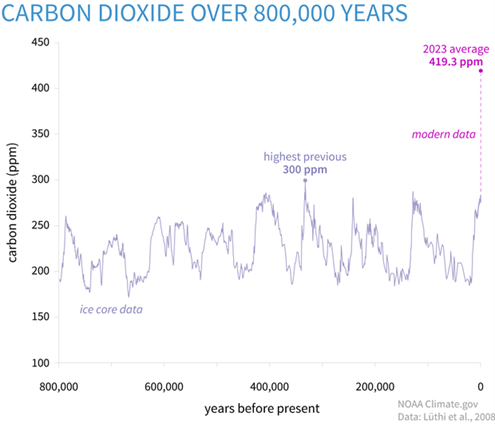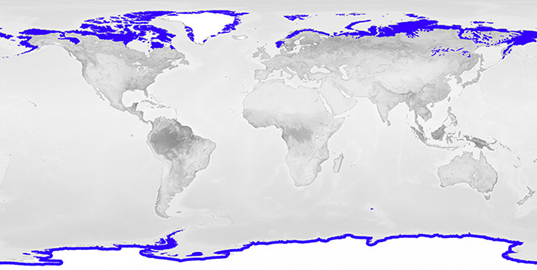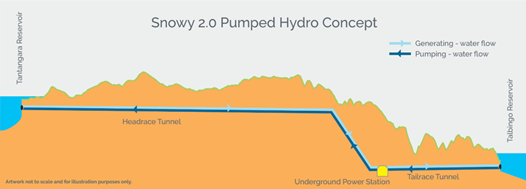Translating deep thinking into common sense
Why the “Greens” are Really “BROWNS”

By Mark Tier
December 11, 2024
SUBSCRIBE TO SAVVY STREET (It's Free)
Around the world, the Greenies are fiercely lobbying for a reduction in the amount of CO2 we are pumping into the atmosphere. Their claim that atmospheric CO2 is increasing as a result of human activities, and will lead to higher temperatures worldwide, has led governments around the world to restrict and penalize activities that produce carbon dioxide, closing down energy production from coal and gas plants.
There’s no question they are right that CO2 is rising, as this chart[1] demonstrates:

As carbon dioxide absorbs heat, there’s no doubt that the increase in atmospheric CO2 will result in a higher air temperature.
A second source of global warming is . . .
The “Heat Island” Effect
Cities, which are a dense area of heat-producing gadgets: cars, trucks, air conditioners in summer, and heaters in winter—not to mention their concentration of asphalt roads which, being black, absorb heat. For example, the temperature in Los Angeles as I write these words is 870F/30.60C, while in Covina, just 22 miles (35.4km) inland, the temperature is 800F/270C.
But: Are rising temperatures necessarily a bad thing? Consider what happens when the earth gets warmer and the amount of CO2 in the atmosphere increases:
- As the earth warms, the frozen areas of tundra [blue in the picture below] will begin to (very slowly) recede. (Tundra comes from the Finnish tunturia, meaning “treeless plain”: areas where nothing grows.) As temperatures rise, the amount of arable land will sluggishly expand, especially in northern Canada, Europe, Russia, and Greenland as the frozen earth of the tundra begins to melt.

- Secondly, existing plants whether in the Amazonian jungle or the corn and wheat fields of North America and Russia will gobble up the increased CO2 and grow faster and larger, reducing the amount of CO2 in the atmosphere.
- In addition:
The ocean generates 50 percent of the oxygen we need, absorbs 25 percent of all carbon dioxide emissions and captures 90 percent of the excess heat generated by these emissions. It is not just ‘the lungs of the planet’ but also its largest ‘carbon sink’—a vital buffer against the impacts of climate change [Emphasis added].[i]
- At the same time, higher ocean temperatures will increase the evaporation of water from the world’s oceans. Water, carbon dioxide, fertilizer, and sunshine are the four necessary fuels for growing plants of every kind. In nature, fertilizer comes from the decay of dead leaves, broken branches—and the poo thoughtfully provided by the world’s birds and animals. So:
- Global warming plus more rain and CO2 has the inevitable effect of increasing plant growth everywhere—whether in Africa, the Amazon or northern Greenland.
- Eaporation increases the world’s cloud cover, the result will be a decrease in the amount of sunshine, so partially compensating for the rising temperature.
To an extent, then, the effects of the warming caused by increased CO2 can be self-correcting, in which case, global warming could cause the “greening of the world.” However, if the Greenies achieve their aims, thanks to the reduction of one of the four essential fuels for plant growth—CO2—the actual result could be the browning of the world: the exact opposite of what Greenies say they wish to achieve. At an enormous expense.
But . . . the Evidence is Contra-Green!
As detailed in a study titled “Greening of the Earth and Its Drivers,” published in Nature Climate Change, the authors used . . .
. . . three long-term satellite leaf area index (LAI) records and ten global ecosystem models to investigate four key drivers of LAI trends during 1982–2009.
We show a persistent and widespread increase of growing season integrated LAI (greening) over 25% to 50% of the global vegetated area, whereas less than 4% of the globe shows decreasing LAI (browning).
Factorial simulations with multiple global ecosystem models suggest that CO2 fertilization effects explain 70% of the observed greening trend, followed by nitrogen deposition (9%), climate change (8%) and land cover change (LCC) (4%). CO2 fertilization effects explain most of the greening trends in the tropics, whereas climate change resulted in greening of the high latitudes and the Tibetan Plateau.
LCC contributed most to the regional greening observed in southeast China and the eastern United States [Emphasis added].[3]
The Greens’ “Solutions”
The proffered solution to climate change, which has been pretty much accepted worldwide, is to reduce the amount of CO2 human activities release into the atmosphere. (The implication is that we are the problem, with the innuendo that we are guilty.) Technological solutions (other than renewable energy), however, are off the table, even though technology offers several simple solutions.
For example, consider volcanoes. Volcanic eruptions actually cool the planet because the particles ejected from volcanoes shade incoming solar radiation. The cooling effects dissipate as the dust and other particles disintegrate or fall to earth, and thus the cooling effect can last for months to years depending on the scale of the eruption.[4]
In the winter of 43 BC, the volcano Mount Okmok, situated on a remote Aleutian island in the north Pacific Ocean, erupted. It was . . .
the largest eruption in the Northern Hemisphere in the last 2,500 years. It produced a sudden and massive drop in global temperatures that persisted for a decade. Tree ring records from the White Mountains of California mark the decade between 43 and 33 BCE as the second-coldest in the Northern Hemisphere in human history. The Okmok eruption injected sulfur dioxide into the stratosphere. . . . Like a giant umbrella, the aerosols reduced the amount of sunlight that reaches Earth’s surface.[5]
On the other side of the world,
Italy endured severe cold summers that disrupted agriculture. And in Egypt, the Nile failed to flood for several years in a row.[6]
The result being famine, starvation, and disease. The 1816 eruption of Mount Tambora, in Indonesia, caused “the Year Without a Summer,”
when frosts and lack of sunshine killed crops in New England and throughout Europe.[7]
The historical “verdict” is clear: volcanic eruptions have, can, and will cool the planet. Whether we like it or not.
It is quite within our capabilities to duplicate the “volcano effect” by erecting large chimneys that could pump dust into the upper atmosphere—or even better, water: if such chimneys were placed in mountainous areas of the world like the Rockies, Andes, Alps, and Himalayas, the effectively unlimited resource of snow and ice could increase the world’s cloud cover, thus reducing global temperatures. With the side benefit of increasing rainfall—and plant growth (and the consumption of CO2).
Another technological solution would be to launch satellites which spread “wings” to reflect sunlight away from the earth as they orbit, resulting in temperature-reducing shade at ground level. This would have the advantage that unlike the Greens’ other “solutions,” such satellites would shade the earth 24 hours a day. Every day. Replicating the “volcano effect” or satellites in space would avoid the inescapable consequences of the Greens’ “solutions” of renewable energy: rising electricity prices adding to inflation; and the blackouts that will inevitably occur when the sun ain’t shining and the wind ain’t blowing and the tide ain’t tiding.
Storing Renewable Energy
Another solution to the fluctuations in the renewable energy supply is to use batteries to store electricity during the day and return it to the grid at night. In Adelaide, South Australia, Tesla built a 100MW/129MWh battery “Power Reserve” which came online in November 2017. A 50MW/64.5MWh expansion was completed in September 2020.[8] The net result, as the following table demonstrates, shows that of Australia’s four major Eastern states, South Australia has the highest electricity rates by a substantial margin:
| Average Electricity Rates | ||
| State | $ per kWh | % difference |
| South Australia | $0.36 | 70.13% |
| New South Wales | $0.29 | 34.97% |
| Queensland | $0.25 | 19.82% |
| Victoria | $0.21 | |
| Source: Average Electricity Prices in Australia | ||
Pumping Hydro
A related option—when hydro is a substantial source of power—is to use the power from wind and solar during the day, when renewables are at their peak energy production levels, to pump water from the lower dams to the higher ones. This sounds like a practical solution. Hydroelectric plants could reduce electricity production during the day when solar can make up the difference. And then release that power at night. However, there are two rather significant obstacles:
- Hydroelectric plants are built to move electricity in one way only: into the grid. For solar power to be received at the hydro end, an entirely new set of transmission lines must be constructed to bring solar energy to the hydro plant. This is not a cheap proposition—especially when hydro plants are a long way from anywhere.
- One factor that makes hydro an economical energy source is gravity: water naturally flows downhill. To bring that water back up, channels, tunnels, and pipes must be built so that water can be moved uphill. To this must be added the cost of installing the necessary pumps that will move that water through the pipes.
On the surface, using renewables to pump hydro sounds like a fairly attractive idea, and exactly this proposal was initiated in 2017 by Australia’s Snowy Hydro Limited, which operates “a hydroelectricity and irrigation complex in south-east Australia. The Scheme consists of sixteen major dams; nine power stations; two pumping stations; and 225 kilometers (140 miles) of tunnels, pipelines and aqueducts that were constructed between 1949 and 1974.”[9] In 2017, it was projected the Scheme to pump water uphill would be completed in four years at a cost of A$2 billion—with no government or taxpayer subsidy needed. Come today, however, the completion date is now estimated to be 2026 (a date that many critics think is far too optimistic) while the total estimated cost has blown out to A$10 billion. In sum:
“Far from bringing electricity prices down, Snowy Hydro’s own modelling predicts that [electricity] prices will rise because of Snowy 2.0.”[10]

On the surface, despite its considerably greater expense, hydropower seems to be a very “Green” solution. But is it? Not according to the New Scientist, as an article titled “Hydroelectric Power’s Dirty Secret” revealed:
The green image of hydro power as a benign alternative to fossil fuels is false, says Éric Duchemin, a consultant for the Intergovernmental Panel on Climate Change (IPCC). “Everyone thinks hydro is very clean, but this is not the case,” he says. Hydroelectric dams produce significant amounts of carbon dioxide and methane, and in some cases produce more of these greenhouse gasses than power plants running on fossil fuels. Carbon emissions vary from dam to dam, says Philip Fearnside from Brazil’s National Institute for Research in the Amazon in Manaus. “But we do know that there are enough emissions to worry about.” In a study to be published in Mitigation and Adaptation Strategies for Global Change, Fearnside estimates that in 1990 the greenhouse effect of emissions from the Curuá-Una dam in Pará, Brazil, was more than three-and-a-half times what would have been produced by generating the same amount of electricity from oil.[11] [Emphasis added]
The “Greening” of the World
As governments act to counter the expectation of rising temperatures, the net result is a significant increase in government interventions. Laws and regulations that reduce the choices available to us all. Those restrictions include:
- Closing down power plants fueled by coal and gas;
- Carbon pricing: effectively a tax on CO2 emissions;[12]
- Subsidizing the production of the “renewable energies” produced by solar, wind, hydro, and tidal;
- Investment in batteries and other methods of storing energy from renewables to be returned to the grid at nighttime;
- In some countries: investing in nuclear power plants which are CO2-free;
- While other countries (like Germany) aim to close down all nuclear production;
- While many countries with no nuclear production refuse to even consider turning to nuclear power.
The overall problem that results from these policies is the questionable consistency and reliability of electricity production. Sources of renewable energy cannot be relied upon to produce power 24 hours per day. Furthermore, the production of energy will fluctuate with the amount of sunshine, wind, or tidal movement. It is also inevitable that there’ll be times when all those three sources of “green” energy produce zero output.
In sum, the Greenies’ proposed “solutions” to the climate change “crisis” cannot guarantee the uninterrupted supply of electricity to consumers. And can only be implemented at an enormous expense. Meanwhile (if the Greenies have their way), the only CO2-free source of electricity is off the table:
Nuclear: the ONLY 24-Hours a Day CO2-Free Source of Electric Power
Like it or not, nuclear power plants are the only “green” all-day-and-night sources of electricity. The European Union agrees, labelling “nuclear and gas as sustainable.”[13] Currently, 440 nuclear power reactors produce about 10% of the world’s electricity. Plus, 53 power reactors are under construction in fifteen countries:
| Argentina | 1 |
| Bangladesh | 2 |
| Belarus | 1 |
| China | 20 |
| Egypt | 1 |
| France | 1 |
| India | 8 |
| Iran | 1 |
| Russia | 3 |
| Slovakia | 2 |
| South Korea | 3 |
| Turkey | 4 |
| UAE | 2 |
| UK | 2 |
| USA | 2 |
| TOTAL | 53 |
A major obstacle to the spread of nuclear power is fear. People are afraid of radioactivity; the presumed danger of nuclear explosions; how to dispose of nuclear waste—which can have a half-life of up to 24,000 years[14]; not to mention the possibility that nuclear waste could be processed into more nuclear bombs (which it can’t).
Various examples of nuclear accidents feed this fear. The worst example ever was the Chernobyl disaster in the Ukraine in 1986. Which spread huge amounts of radioactive waste across Western Europe.
“The nuclear disaster was the product of a flawed Soviet reactor design coupled with serious mistakes made by the plant operators.”[15]
Another Russian nuclear disaster occurred in Kyshtym in 1957 after a faulty cooling system was not repaired. Nuclear fallout spread more than 300 kilometers away. Buying a Soviet-era nuclear reactor would be a big mistake. And in 2011, a 9.0-on-the-Richter-scale earthquake resulted in three reactor meltdowns in Fukushima, Japan. The worst possible mistake anyone could make would be to build a Soviet-era reactor in an earthquake zone!
In October 1957 a raging inferno swept through the core of a nuclear reactor at Windscale, in the UK, for three days, dumping radioactive contamination across Europe. Windscale’s two piles had been hastily built during the British atomic bomb project in the 1940s. Early (and faulty) technology which—like the Soviet reactors—has since been discontinued. And in 1979 a reactor at Three Mile Island, in Pennsylvania, suffered a partial meltdown. In this case, there were no injuries or discernible health impacts.
Total deaths from, or related to, nuclear reactor accidents are between 236 and 11,520.[16] Disastrous as these accidents were, however, they pale when compared to the world’s worst man-made disasters:
| Disaster | Type | Death toll | Date | Location | |
| 1 | World War II | War | 70–118 million | 1939–1945 | Worldwide |
| 2 | Taiping Rebellion | War | 20–40 million | 1850–1864 | China |
| 3 | Great Chinese Famine | Famine | 15–55 million | 1959–1961 | China |
| 4 | World War I | War | 15–22+ million | 1914–1918 | Worldwide |
| 5 | An Lushan Rebellion | War | 13 million | 755–763 | China |
| 6 | Tongzhi Hui Revolt | War | 10 million | 1862–1877 | China |
| 7 | Soviet collectivisation | Famine | 4.4–9.1 million | 1932–1933 | Soviet Union |
| 8 | Russian Civil War | War | 5–9 million | 1917–1921 | Russia |
| 9 | Holocaust | Genocide | 6 million | 1933-1945 | Germany/ Europe |
| 10 | Second Congo War | War | 2.5–5.4 million | 1998–2003 | Congo |
| 11 | Korean War | War | 1.5–4.5 million | 1950–1953 | Korea |
| 12 | The “Killing Fields” | Genocide | 1.5–2.5 million | 1975–1979 | Cambodia |
| 13 | Nigerian Civil War | War | 1–3 million | 1966–1970 | Nigeria |
| 14 | Armenian genocide | Genocide | 600,000–1.5 million | 1890s-1916 | Turkey |
| 15 | Indian Rebellion of 1857 | War | 800,000-1 million | 1857–1858 | India |
| 16 | Bangladesh Liberation War | War | 200,000–3 million | 1971 | Bangladesh |
I’m sure you’ll notice that the common causal factor behind every item on the above list is identical: Government.
The fear of nuclear power is analogous to the fear of flying. People with this common phobia will happily get in their cars or walk across a street even though there are some 40,000 deaths per year from traffic accidents in the US alone. By comparison, there is an average of only about 500 deaths per year worldwide from plane accidents, and most of these involve light aircraft or helicopters rather than jumbo jets.
A similar paradox of human behavior is that the same people who would refuse to live within a thousand miles of a nuclear reactor would happily stream down to the military recruiting centers to sign up to kill or die for their country when it goes to war. This is behavior that I, as a Vietnam veteran, consider completely insane.
One other thing: those who think that climate change is not a problem are labelled as “skeptics” or “deniers.” These are terms that religious fundamentalists freely use to describe atheists, agnostics, and those who worship the “wrong” god(s).
The solution to the issue of climate change is a logical, scientific one and must first answer the question of whether it’s a real problem or not. Smears—and that’s what they are—like “skeptics” and “deniers” have no place in a scientific debate. But it’s good politics. Which suggests that the “Green Revolution” may be as much (if not more) a religious than a scientific issue.
Notes
[1] https://www.climate.gov/news-features/understanding-climate/climate-change-atmos
[2] The ocean—the world’s greatest ally against climate change: https://www.un.org/en/climatechange/science/climate-issues/ocean#:~:text=The%20ocean%20generates%2050%20percent,the%20impacts%20of%20climate%20change
[3] From Nature Climate Change (abstract): https://link.springer.com/article/10.1038/nclimate3004?utm_source=nature&utm_medium=referral&utm_campaign=buyArticle#Abs2
[4] How massive volcano eruptions can alter global temperatures
[5] The volcanic eruption in Alaska that rocked ancient Egypt
[6] Ibid.
[7] Ibid.
[8] https://hornsdalepowerreserve.com.au/
[9] https://en.wikipedia.org/wiki/Snowy_Mountains_Scheme
[10] Five years on, Snowy 2.0 emerges as a $10 billion white elephant.
[11] Hydroelectric power’s dirty secret revealed | New Scientist
[13] https://www.dw.com/en/european-commission-declares-nuclear-and-gas-to-be-green/a-60614990
[14] Backgrounder On Radioactive Waste
[15] The five worst nuclear disasters in history
[16] Compiled from Wikipedia. In some cases, the precise number is disputed or estimated.








